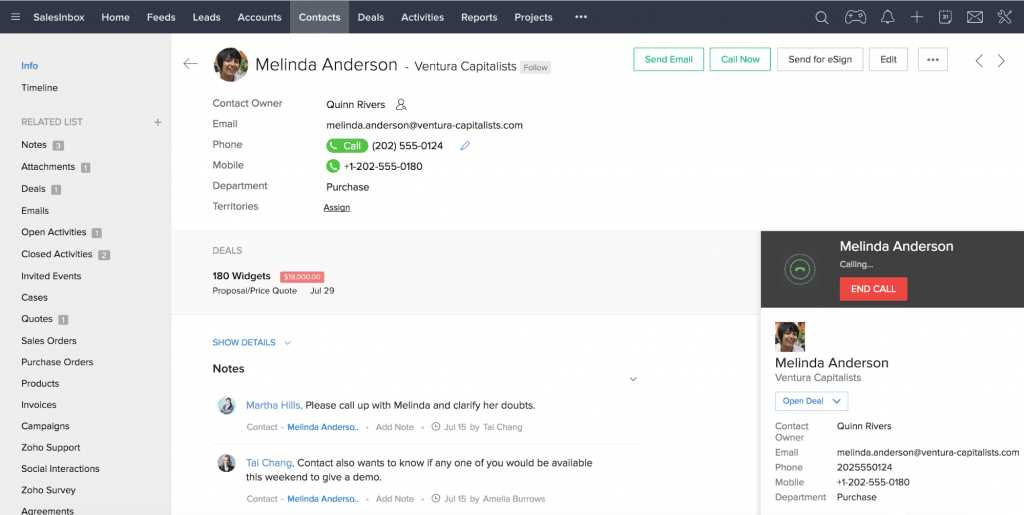It’s not often you’re encouraged to tell a customer “no.” After all, no matter what your role, it’s your job to make sure customers or clients are satisfied—meaning you’re sometimes expected to take on their every request (even if it’s a bit unreasonable).
But have you ever been in a position where you’re tackling a challenge you’re not sure how to complete, in over your head, and thinking “I really shouldn’t have agreed to do this”?
We’ve all been there—biting off more than we can chew in the name of making a client happy. But at the end of the day, not saying no when you really wanted to (and rightfully should have) doesn’t benefit anyone. You end up stressed, rushed, and unfocused—while your client gets a slapped-together solution that might not even solve their problem. Even though you had good intentions, the result is… bad customer service.
It’s not easy to tell someone no—especially a client whose business you’d like to keep. Luckily, you don’t have to choose between taking on every request and keeping your clients. It is possible to respectfully tell your client no while still keeping them on board.
Let’s look at five ways to say no to a customer—in a constructive way:
- Understand the root of their request
- Offer alternative solutions
- Keep a log of your conversations
- Make the customer feel heard
- Give an honest reason why
How customer-obsessed is your business? Take the quiz. 💚
1. Understand the root of their request
When a customer makes a request that might be outside your normal scope of work, it can be tempting to immediately dismiss it. Maybe the request is outside your capabilities or it requires a complete overhaul of your products or services (something you don’t intend to do).
But immediately writing off a client’s ask can make that person feel like they’re not important to you—and you want to avoid being the star of someone’s bad customer service story, right?
Even worse, if you don’t understand why they’re asking that of you, a need you could solve might continue to go unaddressed, leaving your client feeling unsatisfied and potentially looking for an alternative solution.
Before you say no to a customer, try to understand the root of their request. What are they really asking for? What problem are they trying to solve? Is there an alternative solution that you can easily provide?
Find the problem behind the request and make sure you can’t solve it before saying no.
Here’s an example.
Let’s say you are a small healthcare provider and recently introduced a new online portal for scheduling appointments. A client reaches out asking if you can change your scheduling system back to the way it was before.
While you might not have any interest in changing your system again, simply dismissing the client and saying no doesn’t help anyone very much. Instead, you can ask what they miss about the old scheduling tool or what they’d like to see come back.
Talking through the request to find out what the client really wants gives you a better understanding of their needs, and puts you in a better solution to solve their issue—even if it means not agreeing to their request.
Going back to our example, the client might just need a bit of help navigating the new system or they might need to be made aware of alternative methods for making an appointment. You can then provide them with the resources they need to solve the root of their issue.
Better understand your customers with an omni-digital customer engagement strategy.
Getting to the root of customer requests all comes down to properly understanding their needs. But in order to do that, you need to make it easy for customers to engage with you.
Allowing them to reach out through the tools they enjoy for personal communication puts customers in their comfort zone, making it easy to converse so you can get to the bottom of what they’re asking for.
2. Offer alternative solutions
We all want to offer the perfect solution for everyone. Unfortunately, this isn’t really realistic. Sometimes a client just outgrows what you have to offer or their needs change enough that you’re no longer the right solution for them—and that’s okay.
But when this happens, you need to do more than just say “sorry, we can’t help you” (although it can’t hurt to be ready with the apology letter) or offer piecemeal workarounds that only half address the problem.
Instead, point your customer in the direction of a product or solution that better suits their needs—even if it means directing them to a competitor. Although it might seem counterintuitive to admit when a competitor is better at solving a specific challenge, it can generate goodwill with the customer.
In this instance, you’re sacrificing your own needs (gaining revenue for your business) in favor of the customer’s needs, and that’s not something they’ll be quick to forget. While this might result in some short-term losses, it could encourage the client to use word-of-mouth marketing to help push new clients in your direction.
Follow up with customers on alternatives or workarounds.
If it comes down to needing to recommend another product or service to your customer, it can feel like you’re nudging them out into the world to figure things out on their own. While you can certainly wash your hands of that customer and never think about them again, this kind of attitude does little to create brand advocates who might refer new business to you.
But how do you keep in touch with a client who no longer needs your products or services?
By sending a simple follow-up message.
Following up with customers (even if they’ve needed to move on) allows you to double check that their problem was solved, even if you’re unable to help them yourself. It also shows you’re still interested in that individual’s well-being, and can re-spark the conversation if they haven’t found a viable alternative.
[ebook-download title=”How customer-obsessed is your business?” link=”https://netstorage.ringcentral.com/documents/quiz_how_customer_obsessed_your_business.pdf” cta-text=”Take the quiz” src=””]
Here’s an example of a follow-up message you could send:
Hi [Client Name],
Last time we spoke, you were looking for [feature or service] to help you solve [challenge]. I recommended looking into [alternative/workaround] and wanted to follow up to see if you were able to find the solution you were looking for.
Let me know how this worked out for you!
If possible, send this follow-up message through whatever channel the customer originally contacted you, whether that be through a phone call, email, or social media. That’s a pillar of omnichannel customer service (and using an omnichannel communications platform like RingCentral can make this process easy).
RingCentral uses a single platform to manage customer interactions, so you don’t need to switch between various accounts to find who to follow up with and how.
3. Keep a log of your conversations
Although you don’t want to constantly have to tell your customers no, chances are you’ll probably need to have those difficult conversations more than once. But each time you need to tell a customer no can be a learning experience for the next conversation.
Keeping a log of conversations with customers can give you something to refer back to. You can see what worked well and what didn’t so you can start telling customers no in a more elegant way.
Logging customer conversations can also help you better understand what requests or concerns each individual customer has brought up in the past. This allows you to better understand where that client is coming from so you can make better recommendations based on the whole picture, not just what they’re saying now.
Integrate your communication tool with a CRM to keep conversations moving forward.
Conversations can’t move forward if you have no idea what you discussed the last time someone on your team spoke to a client. And asking clients to repeat themselves over and over is tiresome.
A CRM can help you keep track of the dozens of customer conversations you have every day.
By integrating a CRM like Zoho into RingCentral, you’ll have all the information you need for when a customer comes to you with a request, including requests they might have made in the past and what alternatives they’ve already tried:
In the CRM, you’ll be able to see if other team members have already told this customer no before (or what ways they might have said no that didn’t work).
This prevents you from needing to repeat yourself—and can reduce frustration because your client won’t have to hear the same advice over and over. Catching yourself up on past conversations regularly also gives you the ability to make more personalized recommendations because you’ll be able to see past questions or suggestions, giving you a more complete look at what the customer needs.
4. Make the customer feel heard
Many of us avoid saying no to customers because we’re worried about ruining the relationship we’ve created—and it makes sense. A curt no to a request that seems reasonable to the customer can feel dismissive and off-putting.
But we’re not suggesting you shut the customer down completely. Although you may not be able to provide them with what they’re looking for, you want to be sure your customer feels heard and understood.
Know how to apologize in a genuine way and avoid giving canned one-size-fits-all responses. When possible, use the language they used in their request or dive deeper into what they’re asking for to show you’re listening.
And remember to keep your language positive. No one likes to be told no, but if you approach the conversation correctly and continue to make the customer feel heard and understood, you can avoid ever actually using the word.
Here are some things you can say to make your customer feel heard and understood:
- “That sounds like a really useful feature to have.”
- “I understand why you’d want to have that feature/service.”
- “We love hearing ideas from our customers.”
- “Having that feature would be great for solving [problem].”
5. Give an honest reason why
Beyond just feeling heard, an angry customer usually wants to know why their request can’t be fulfilled. Without clear reasoning, they might default to assuming you just don’t care enough to put in the effort to help them solve a particular problem or implement the solution they’re asking for.
But if you’re not honest about the reason why you’re unable to help, it can feel like you’re making excuses.
Providing a clear, honest reason why you need to say no to their request can help them better understand where you’re coming from. It also presents an opportunity to have an open discussion about your company’s offerings and whether or not you’re the right tool or product for their needs (more on this a bit later).
Honesty prevents you from wasting anyone’s time. Although it might be tempting to say you’ll pass information along or you’ll take a stab at trying something out when you really have no intention of doing so, it can come back to bite you.
Here are some ways you can start your explanation:
- “Let me explain why we can’t implement this feature right now…”
- “The reason we’re unable to fulfill this request is because…”
- “We appreciate you sharing this feedback with us. Unfortunately, we can’t add this feature or service at this time because…”
Saying no to a customer doesn’t mean losing their business
Needing to tell a customer no doesn’t need to feel like you’re automatically losing their business. However, to remain respectful and keep the conversation going, you need to say no the right way.
These tips can help you get more comfortable with saying no to customers, but be sure to constantly look for ways to refine your messaging. As you learn what resonates with your customers and what doesn’t, you can start to craft more elegant and effective ways to say no.
Originally published Apr 02, 2020, updated Feb 26, 2021







